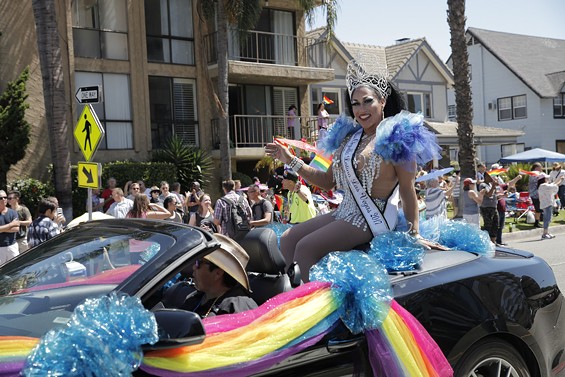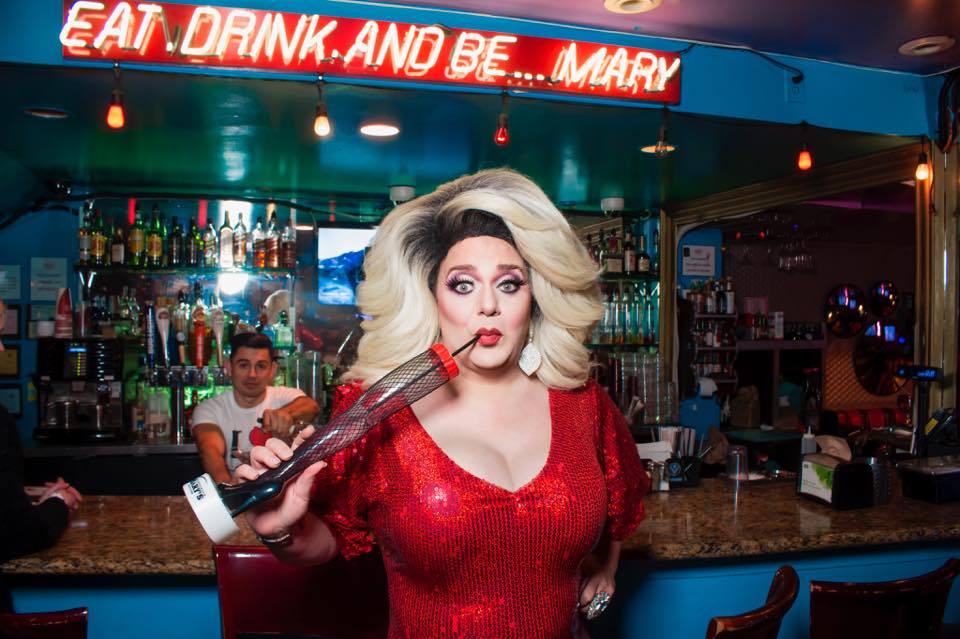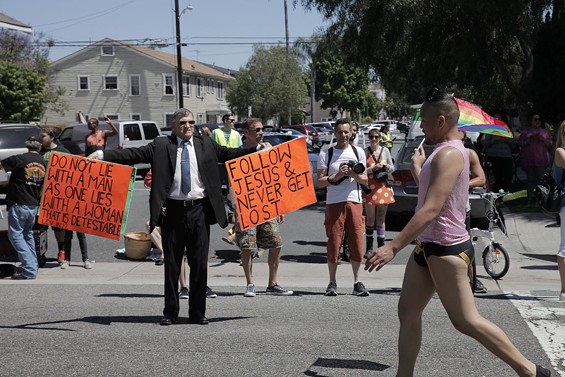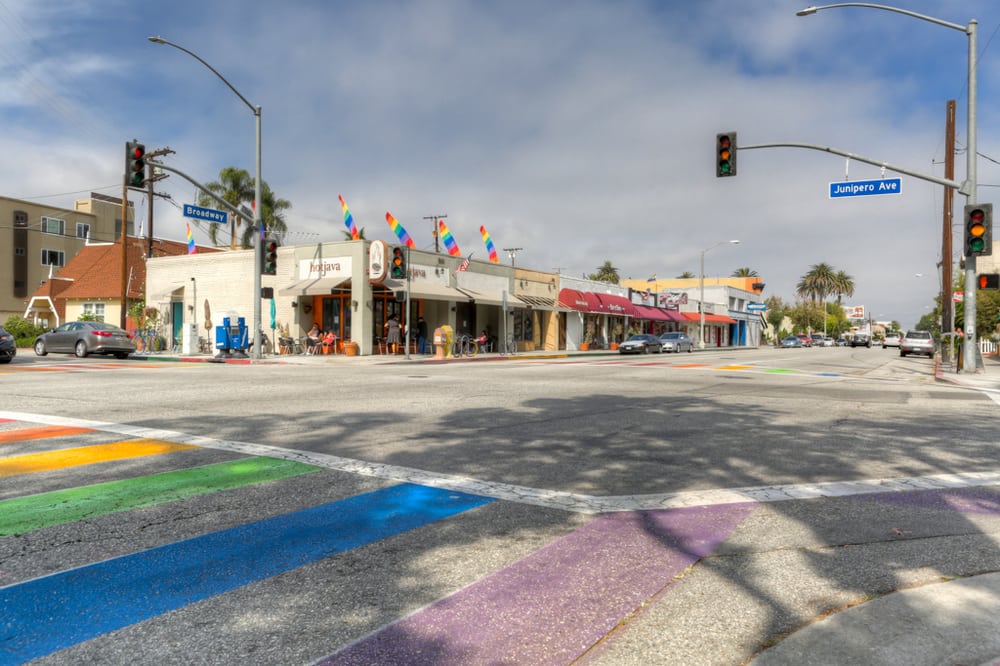
Long Beach Pride, much like the city itself, is the odd duckling when it comes to Pride celebrations.
Not free like San Francisco’s party nor trying to be Gaychella like LA’s respectful version, Long Beach Pride is its own beast. It’s relatively cheap. It’s old-school in a warming sense. (Sheila E is headlining this year.) It’s divey in the best way possible. (Just like the Gayborhood bars.)
But perhaps most respectful aspect—and, at least for the newer generation, also its most frustrating—is its homage toward those who made it all possible. Creating Long Beach Pride was more than just sending a parade down Ocean Blvd.
It was and remains a culmination of the brave battling a plethora of forms of fear mongering, of people coming out of the closet, of people believing in the vitality of Long Beach as a city of diversity.
Here are just a handful of moments, places, and people—both here and gone—that make Pride more than a parade.

Jewels
Jewels is a drag giant whose was name recently etched onto the wall that honors local LGBTQ leaders and luminaries in DTLB’s Harvey Milk Park. Don’t get it twisted: Jewels is not just queer royalty but the true Queen of Long Beach. (Take a seat, Mary.)
Long before Hamburger Mary’s moved to its far more grandiose location in DTLB and even longer than the time when Angelenos finally began trekking below the 10 to actually explore Long Beach, Jewels was watching a scene that was disconnected between an aging population still devastated by AIDS and a free, albeit more naïve group of young queers desperate for rainbow havens.
So she decided to do something about it.
Night after night—be it at the now-defunct but forever-remembered Fire Island or the Falcon, Mineshaft or Mary’s—Jewels would host evenings, post fliers, and perhaps most importantly, connect people in ways that most hadn’t thought Long Beach’s gay community was capable of.
She invigorated new life into the Brunchettes drag brunch. She has led the way in keeping the incredible herstory of the Easter Sunday Drag Walk alive, even as its founders and originators either move or go on to make heaven a more colorful place. She provided a more beautiful night life, one that made sure to include all the bars, catering to each space’s idiosyncrasies and nuances with only the care that an astute drag queen can.
In other words, she softened the chip on Long Beach’s shoulder and made it a little more proud of itself.

That moment when a Long Beach council member said he “didn’t wanna bunch queers in the trees…”
The cavalry of homos marching down Ocean Blvd., often led in the first few parades in the early 1980s by drag queen legend Emperor Boom Boom, didn’t magically just happen.
In fact, after the first parade in 1984 is when those that were agitated by queer life decided to fight the gay community on Long Beach Pride.
Seeking approval the second parade and festival, founders Vanessa Romain, Marilyn Barlow, Bob Crow and Judith Doyle were met with the vitriol of a homophobic City Council. Then-councilmembers Warren Harwood and Edd Tuttle along with former mayors Eunice Sato and Ernie Kell were outspoken opponents of the festival, not to mention critics of LGBTQ rights in general. Harwood explicitly stated he “didn’t want a buncha queers in the trees.”
City Manager John Denver joined the anti-queer coalition, attempting to stifle the celebration to one day and requesting the group provide millions in an insurance policy. Sans proper permits and safety, Boom Boom and crew still walked down Ocean, some sporting bulletproof vests for fear that the hateful’s hate might become more tangible.

The multi-million dollar nonprofit that was born in Long Beach living rooms…
The Center wasn’t always a massive nonprofit that oversees everything from senior programming to HIV/AIDS management to addiction therapy to youth mentoring to legal services…
It began in living rooms across the city in the late 1970s, where men and women sat within a zone of comfort that allowed them to speak on the issues that, at least at the time, society was fearful to address.
Soon after, its role altered: establishing Project Ahead—the AIDS program that was the first of its kind in the region—The Center became a pivotal cog in the crisis that would annihilate almost an entire generation of thinkers, innovators, leaders, and artists as the AIDS crisis swept the nation in the 1980s.
Much like the roller coaster of the epidemic itself, The Center would find itself amidst its own highs and lows over the next few decades. Today, thanks to bold if not outright fearless leadership thanks to its Executive Director Porter Gilberg, it serves over 25,000 folks from across Long Beach and beyond.
North Long Beach’s all-night, drag-centric dance club that defied the homophobia of the 1980s…
It was originally called Impact, nestled at the corner of 61st Street and Cherry Avenue in North Long Beach. It also acted as, at least according to Empress Boom Boom of the Long Beach Imperial Court, the headquarters for drag queens—and for good reason.
“Things were different back then,” Boom Boom, whose legal name is Frank Rubio, explained. “If you were a drag queen like myself, of course you didn’t have a legitimate ID or a picture that verified you were Frank Rubio In Drag. And there were just a lotta bars that frowned upon you—even gay ones. Unless it was Halloween, of course.”
Impact was an all-night, 3,000-square-foot mecca of sorts, located at 6101 Cherry. It stayed open 24 hours on the weekend to cater to the dancers and drags that never wanted the party to halt. People knew people and the bar had had an unrestricted license for years.
In 1985, allies Robert and Sylvia Oliver—who already owned a downtown bar—purchased Impact and changed it to Club Sylvia without remotely altering its purpose as a drag center. In fact, they catered to it and improved the space both inside as well as with additional lighting in its parking lot.
The next 15 months—from January of 1985 to the following spring in 1986—would become one of the oddest and most controversial City Council battles over a space designed for entertainment. Led by then-9th District Councilmember Warren Harwood and a nearby homeowner and nurse Carol McDonald, a yearlong campaign to stifle Club Sylvia brought about accusations of homophobia, threats to recall Harwood, the misuse of city powers, and a lawsuit that would stretch into the 1990s.
McDonald was the most directly outspoken citizen and her Council appearance on that day sparked a fury of controversy not only when she told the Los Angeles Times that people “putting on their wigs and clicking their high heels” is not what she “likes [for] my children,” but when she proclaimed that Club Sylvia wasn’t a neighborhood bar.
Her proof? When she saw men in women’s attire on April 30 of that year—later proved to be a benefit for the aforementioned AIDS nonprofit Project Ahead—she said she knew police checked their license plates and discovered many patrons were from the L.A. basin and not Long Beach directly.
Though the saga of this ol’ drag bar is far more lengthy and complicated, perhaps the space was simply plagued, as Rubio put it, after Impact went away—but one thing remained true: men wouldn’t stop putting on heels and queers wouldn’t stop fighting for the spaces they needed to live more fulfilled lives.

Those rainbow crosswalks though…
Perhaps, amidst all this history—some outright beautiful, other parts not so much—the thing we can perhaps most be proud of is a city which now accepts its gayness with such a passion that, through the stretch of the Gayborhood that sits along Broadway between Junipero and Alamitos, the crosswalks display a bright rainbow.
Because that’s not just something to be proud of—it’s direct proof of the power of human resilience.
Full disclosure: Brian Addison currently serves as a Board Member at the LGBTQ Center of Long Beach, having been appointed earlier this year to the volunteer post.


One Reply to “Five Things That Make LB Pride More Than a Parade”